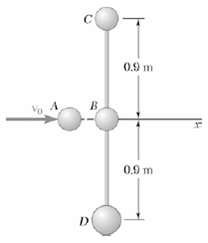Four small disks A, B, C, and D can slide freely on a frictionless horizontal surface. Disks
Question:
Four small disks A, B, C, and D can slide freely on a frictionless horizontal surface. Disks B, C, and D are connected by light rods and are at rest in the position shown when disk B is struck squarely by disk A which is moving to the right with a velocity v0 = (12 m/s)i. The masses of the disks are mA = mB = mC = 7.5 kg, and mD = 15 kg. Knowing that the velocities of the disks immediately after the impact are vA = vB = (2.5 m/s)i, vC = vC i, and vD = vD i, determine
(a) The speeds vC and vD,
(b) The fraction of the initial kinetic energy of the system which is dissipated during thecollision.

Step by Step Answer:

Vector Mechanics for Engineers Statics and Dynamics
ISBN: 978-0073212227
8th Edition
Authors: Ferdinand Beer, E. Russell Johnston, Jr., Elliot Eisenberg, William Clausen, David Mazurek, Phillip Cornwell





